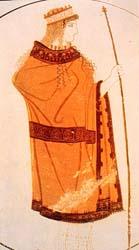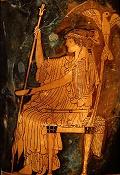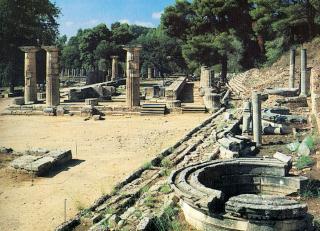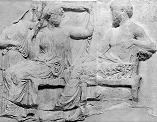
 |

|
Roman Name: Juno Sacred Region: Argos (in the Peloponnesus) Totem Animals: Peacocks and Cows Totem Plant: Lily How to Identify Her: Crown or diadem on head |
Images of Hera, courtesy of Laurel Bowman at the University of Victoria
 Ox-eyed, white-armed Hera is primarily active in her role as the protector of marriage.
She's a very old goddess whose name probably goes back to pre-Hellenic times (unlike her
husband Zeus, whose name is quite Greek and is a form of the word "god"). As Powell tells
us, several scholars have suggested that Hera is probably a feminine form of hero,
designating a great and powerful lady--an interesting idea, given the fact that other scholars
have asserted there is no such
thing as a female hero in the Hellenic tradition. Her association with cattle might also
indicate a connection with the bull worship in the Minoan period.
Ox-eyed, white-armed Hera is primarily active in her role as the protector of marriage.
She's a very old goddess whose name probably goes back to pre-Hellenic times (unlike her
husband Zeus, whose name is quite Greek and is a form of the word "god"). As Powell tells
us, several scholars have suggested that Hera is probably a feminine form of hero,
designating a great and powerful lady--an interesting idea, given the fact that other scholars
have asserted there is no such
thing as a female hero in the Hellenic tradition. Her association with cattle might also
indicate a connection with the bull worship in the Minoan period.
Powell suggests that Hera was originally a mother goddess who "sponsored the fertility of cattle and crops" (148). Another indication of a fertility goddess role in her past is the fact that she is associated with the Milky Way. Our word galaxy comes from the Greek gala, or milk; the ancient Greeks claimed that the Milky Way was formed from the milk of Hera's breasts and that the drops that fell to the ground became lilies. Some commentators have pointed out that lilies' physical resemblance to female genitalia are yet another indicator of a fertility dimension to Hera's nature. Unlike her sister Demeter, who is associated almost entirely with the fertility of crops, when we talk about Hera and fertility we are usually talking about sexual reproduction. Also unlike Demeter, Hera is more interested in the sexual relationship than in the outcome--the sacredness of marriage is emphasized rather than the sacred tie between parent and child.
Although she doesn't always come off well in mythological accounts, in religious practice Hera was one of the most respected and revered of the goddesses. She is generally shown as being extremely stately and dignified, as in the vase paintings above. She never seems to lose the royal aura that is hers by right as the Queen of Heaven. You will often see her wearing a veil, both to emphasize her mystery and to emphasize her role as a married woman.
It might seem strange that cattle are sacred to Hera when you consider her persecution of poor Io, but remember that Zeus turned Io into a cow in order to fool her. One can understand his reasoning and his hope that turning Io into Hera's favorite animal might avert her anger. Unfortunately, it didn't work out that way. For further details on Io, see Helga's article in the class magazine.
 The plus side of the whole Io incident for Hera was that it gave her
a favorite bird, as a result of the story of her faithful servant Argus (don't confuse
Argus with Argos, which is her favorite region). The Argus legend has hung on
in our culture in an unexpected way, as you'll see if you check the yellow pages in many a big
city phone book: Argus is one of the most popular names for detective agencies and security
systems companies. So the adversarial relationship between Argus and Hermes, protector of
thieves, continues even today.
The plus side of the whole Io incident for Hera was that it gave her
a favorite bird, as a result of the story of her faithful servant Argus (don't confuse
Argus with Argos, which is her favorite region). The Argus legend has hung on
in our culture in an unexpected way, as you'll see if you check the yellow pages in many a big
city phone book: Argus is one of the most popular names for detective agencies and security
systems companies. So the adversarial relationship between Argus and Hermes, protector of
thieves, continues even today.
The peacock, like Hera herself, has two sides to its nature. It is stately and beautiful, but it has an extremely shrill voice that resembles the shrewish character that Hera shows in so many of the myths. It also has a dimension of pride to it, and in the mythology it does seem that it's always a blow to her pride that gets Hera into trouble. As examples, consider the golden apple incident that kicked off the Trojan War and the many stories of Hera's endless pursuit of the women who receive Zeus's amorous attentions.
One of these unfortunate women whom we haven't yet encountered was Aegina (pronounced EGG-in-uh, believe it or not), the daughter of a river god named Asopus. She bore Zeus a son named Aeacus, who was to become the father of Peleus, who was the father of Achilles. Aeacus's other son, Telemon, fathered the hero Ajax, who fought with Achilles at Troy.
To seduce Aegina, Zeus did his usual shape-changing trick and turned himself into either an eagle or a flame, depending on which account you read. He bore the maiden off to a large island in the Saronic Gulf that still bears her name (today it's famous for a beautifully preserved temple to Aphaia--a local deity--and a brisk trade in high-quality pistachio nuts). Aegina's father was furious and searched everywhere for her until he finally ran across Sisypus, the King of Corinth, who had witnessed the abduction. When Asopus came to collect his daughter, Zeus drove him off with his thunderbolts. Sisyphus's fate was rather worse: he was condemned for all eternity to roll a huge rock up a steep slope in Tartarus. Every time he almost gets to the top, the rock slips from his grasp and he has to start all over again.
Hera was so angry about this latest escapade she wiped out almost all of the population of Aegina--which is a pretty large island, so that's a lot of people. The only way the place could be repopulated was by turning the local ants into human beings, so Aeacus--and after him, Achilles--became Ruler of the Ant People. Sounds like a B-grade horror movie, doesn't it? According to some accounts Hera destroyed the people of Aegina with a plague, but according to others she sent a dragon to do the dirty work. I prefer the dragon account because it has such interesting parallels with the story of the Python at Delphi and with the story of Tiamat the dragon in the eastern Enuma Elish, which we studied when we were looking at the creation myths. The plague story, however, is the more popular version.
 |
Another theory is that all the "good stuff" had already been apportioned out to other deities, and there was nothing left over for Hera, so Zeus was planning to offer her the Queen of Heaven job as a sort of consolation prize.
Whatever the case, Hera refused to go along with her brother's plans and turned him down flat. Never one to take no for an answer, Zeus...
...can you guess what he did next?
If you said "I'll bet he changed his shape," you're right. He conjured up a rainstorm near a mountain in Argos where Hera liked to walk, and turned himself into a cuckoo (don't say it. I swear I'm not making this up). After getting thoroughly wet and bedraggled, he turned off the rain and waited. When Hera came along, she sat down for a moment to enjoy the fresh air and rest her feet, and Zeus took the opportunity to crawl into her lap. The sodden bird awakened her sympathy and she kissed it and snuggled it against her breast and...well, the rest is history. On the site where she sat down the Argives dedicated a temple to Hera Teleia, which means "Hera fulfilled." She became the marriage goddess then and there.
Hera had four children: Hebe, goddess of youth (Hebe was originally the cupbearer for the nectar on Mount Olympus, until she was replaced by Ganymede, and eventually she wound up marrying Heracles when he finally was admitted to live with the gods); Eileithyia, goddess of labour pains (speaking of Heracles, Eileithyia is the one who caused Alcmena's nine days of sorrow when she was in labor with him and Hera wanted to hold up the birth); Hephaestus, the artful yet deformed blacksmith of the gods; and Ares, god of war. Some accounts claim that Zeus was the father of all four, but others say that one or both of the sons were produced asexually out of revenge for the birth of Athena from Zeus's head. Because of the unnatural nature of their birth and Hera's anger at the time, neither was quite right: Hephaestus had a beautiful soul but a hideous body, while Ares was beautiful on the outside but twisted and sick on the inside...which, when you think about it, is an awfully good description of exactly what war is like.
Occasionally a fifth child will be mentioned who is wholly monster: Typhon, the dreadful creature created out of sheer vengefulness.
 However he may talk about her behind her back, Zeus is still susceptible to Hera's charms and
he falls for her repeatedly. Not only is there the famous episode from the Iliad
where Hera borrows Aphrodite's enchanted girdle to seduce him--we looked at that when we were
studying Aphrodite--but there's also the case of her annual bath in
Canathus, a sort of spa treatment that renews her virginity and makes Zeus crazy for
her all over again. Here she is on the Parthenon frieze, flirting with him from beneath her
veil.
However he may talk about her behind her back, Zeus is still susceptible to Hera's charms and
he falls for her repeatedly. Not only is there the famous episode from the Iliad
where Hera borrows Aphrodite's enchanted girdle to seduce him--we looked at that when we were
studying Aphrodite--but there's also the case of her annual bath in
Canathus, a sort of spa treatment that renews her virginity and makes Zeus crazy for
her all over again. Here she is on the Parthenon frieze, flirting with him from beneath her
veil.
Because of this interesting ability of hers to repeat the cycle, Hera was worshipped in three different guises: Hera Parthenos, or maiden, in the spring; Hera Teleia in the summer and autumn; and Hera Chera, or Hera the widow, in the winter. She was worshipped all over Greece, just as marriage was celebrated all over Greece, but her main sanctuaries were at Argos, the island of Samos, and the city of Sparta on the Argive plain. That last might seem ironic in light of the fact that Greek literature's most famous adulteress, Helen of Troy, came from Sparta. Apparently Helen didn't listen very well to the local priests!
You can find more information on Hera's principal temples at the Perseus Project (text and images), and From Myth to Mind has an extremely engaging site on her temple on Samos.
There's an interesting legend about the temple at Argos involving two brothers named Biton and Cleobis, which was recounted by the historian Herodotus in the fifth century B.C. I won't spoil the surprise by telling you what it's about--you'll have to check the link.
It would seem that even in this day and age, Hera has her adherents. The ultra-modern feminist poet, H.D. (Hilda Doolittle), wrote a beautiful ode in honor of Hera and Hymen, the deity in charge of weddings, in 1921. And the Jungian psychiatrist Jean Shinoda Bolen, in her book entitled Goddesses in Everywoman (Harper and Row, 1984), claims that the Greek goddesses, especially Hera, are useful as archetypes in her clinical practice. She points out that a woman inspired by Hera is completely taken up in her role as wife to such an extent that other ties, even to one's children, aren't nearly as strong (she cites Nancy Reagan as a modern example). In an interview, she remarks on how typical it is for a woman who defines herself by her marriage to strike out and blame everybody except a philandering husband...just as Hera continually zaps the hapless victims of Zeus's lust.
If the Hera side of an individual gets out of balance, the results can be gruesome. According to Bolen, Ares is a case of "'Like mother, like son'--Ares's uncontrolled fury on the battlefield mirror[s] Hera's out-of-control vindictiveness" (165). Instead, Bolen suggests that Hera could more productively model herself on her other son, Hephaestus, and try to channel her rage and aggressiveness into creative channels. But in all the myths she notoriously shows favoritism to Ares instead.
Medea is certainly the ultimate example of out-of-control rage inspired by Hera. Poor Hera is caught in a peculiar situation in that particular relationship: here's Jason, her favorite, dishonoring the very thing that she represents. No wonder she inspires Medea to go to shocking lengths. But through it all, notice that Medea never harms a hair on Jason's head. Because she defines herself primarily as a wife, the idea of completely destroying her husband would be unthinkable because that would involve destroying her own identity.
To read more about Hera, click here and here for entries from the Encyclopedia Mythica and Perseus, and here for an overview of myths about Hera in capsule form, courtesy of Carlos Parada's Greek Mythology Link. Parada even includes a handy table of "Hera's Wrath," indicating the major characters who got zapped by Hera, and why.